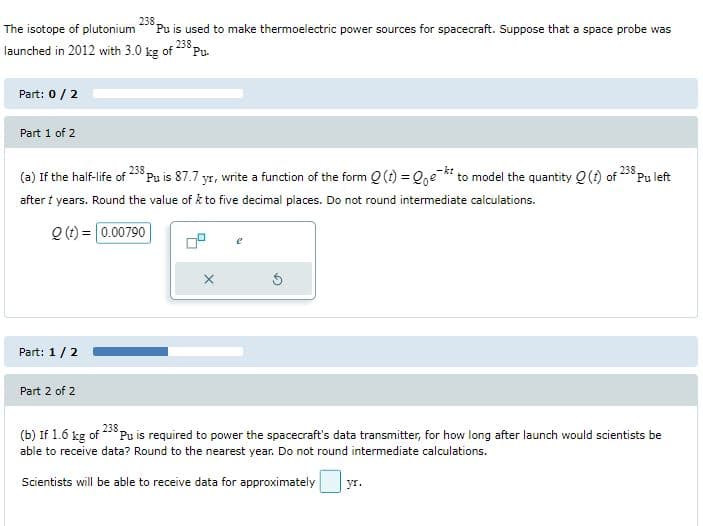238, The isotope of plutonium * Pu is used to make thermoelectric power sources for spacecraft. Suppose that a space probe was 238, launched in 2012 with 3.0 kg of 5°P.. Part: 0/2 Part 1 of 2 (a) If the half-life of 238, Pu is 87.7 yr, write a function of the form Q() = Q,e hi to model the quantity Q (1) of 238 Pu left after t years. Round the value of k to five decimal places. Do not round intermediate calculations. Q (t) = 0.00790 Part: 1/2
238, The isotope of plutonium * Pu is used to make thermoelectric power sources for spacecraft. Suppose that a space probe was 238, launched in 2012 with 3.0 kg of 5°P.. Part: 0/2 Part 1 of 2 (a) If the half-life of 238, Pu is 87.7 yr, write a function of the form Q() = Q,e hi to model the quantity Q (1) of 238 Pu left after t years. Round the value of k to five decimal places. Do not round intermediate calculations. Q (t) = 0.00790 Part: 1/2
Chemistry: Principles and Reactions
8th Edition
ISBN:9781305079373
Author:William L. Masterton, Cecile N. Hurley
Publisher:William L. Masterton, Cecile N. Hurley
Chapter18: Nuclear Reactions
Section: Chapter Questions
Problem 81QAP
Related questions
Question
9

Transcribed Image Text:238,
The isotope of plutonium * Pu is used to make thermoelectric power sources for spacecraft. Suppose that a space probe was
238,
launched in 2012 with 3.0 kg of 25° Pu.
Part: 0 /2
Part 1 of 2
(a) If the half-life of
238,
Pu is 87.7 yr, write a function of the form Q() = Q,e hi to model the quantity Q (1) of
238 Pu left
after t years. Round the value of k to five decimal places. Do not round intermediate calculations.
Q (t) = 0.00790
Part: 1/2
Part 2 of 2
238.
(b) If 1.6 kg of ° Pu is required to power the spacecraft's data transmitter, for how long after launch would scientists be
able to receive data? Round to the nearest year. Do not round intermediate calculations.
Scientists will be able to receive data for approximately
уг.
Expert Solution
This question has been solved!
Explore an expertly crafted, step-by-step solution for a thorough understanding of key concepts.
Step by step
Solved in 2 steps with 2 images

Knowledge Booster
Learn more about
Need a deep-dive on the concept behind this application? Look no further. Learn more about this topic, chemistry and related others by exploring similar questions and additional content below.Recommended textbooks for you

Chemistry: Principles and Reactions
Chemistry
ISBN:
9781305079373
Author:
William L. Masterton, Cecile N. Hurley
Publisher:
Cengage Learning

Introductory Chemistry: A Foundation
Chemistry
ISBN:
9781337399425
Author:
Steven S. Zumdahl, Donald J. DeCoste
Publisher:
Cengage Learning

Chemistry & Chemical Reactivity
Chemistry
ISBN:
9781337399074
Author:
John C. Kotz, Paul M. Treichel, John Townsend, David Treichel
Publisher:
Cengage Learning

Chemistry: Principles and Reactions
Chemistry
ISBN:
9781305079373
Author:
William L. Masterton, Cecile N. Hurley
Publisher:
Cengage Learning

Introductory Chemistry: A Foundation
Chemistry
ISBN:
9781337399425
Author:
Steven S. Zumdahl, Donald J. DeCoste
Publisher:
Cengage Learning

Chemistry & Chemical Reactivity
Chemistry
ISBN:
9781337399074
Author:
John C. Kotz, Paul M. Treichel, John Townsend, David Treichel
Publisher:
Cengage Learning

Chemistry: Principles and Practice
Chemistry
ISBN:
9780534420123
Author:
Daniel L. Reger, Scott R. Goode, David W. Ball, Edward Mercer
Publisher:
Cengage Learning

Principles of Modern Chemistry
Chemistry
ISBN:
9781305079113
Author:
David W. Oxtoby, H. Pat Gillis, Laurie J. Butler
Publisher:
Cengage Learning

Introduction to General, Organic and Biochemistry
Chemistry
ISBN:
9781285869759
Author:
Frederick A. Bettelheim, William H. Brown, Mary K. Campbell, Shawn O. Farrell, Omar Torres
Publisher:
Cengage Learning